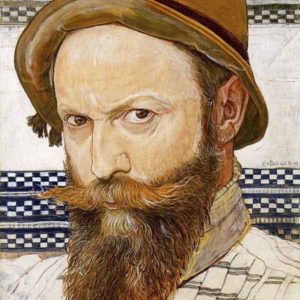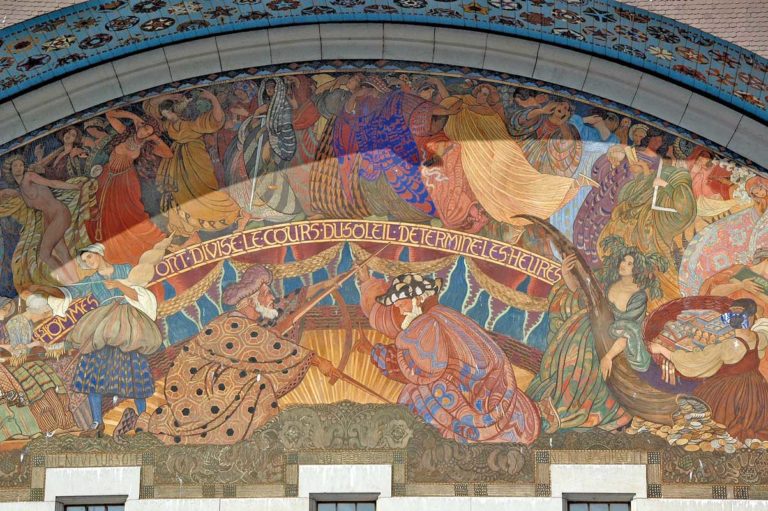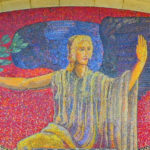Ernest Biéler
[CH]
- ARTIST -
OFF PROGRAM
IN LE LOCLE, IN ADDITION TO THE CREATIONS INITIATED BY THE EXOMUSÉE, WE INVITE YOU TO (RE)DISCOVER A SELECTION OF WORKS THAT CAN ALSO BE DESCRIBED AS URBAN ART SINCE THEY ARE EXHIBITED IN PUBLIC SPACES.

Born in Rolle (VD) in 1863, at the age of 17 Ernest Biéler left for Paris to study art. Initially influenced by Impressionism, his first masterpiece (Pendant la messe à Saint-Germain en Savièse, 1886), inspired by a trip to the canton of Valais, attracted a great deal of attention at the 1889 World Fair. He was able to make a living in France’s capital thanks to his illustrations for novels by Émile Zola, Alphonse Daudet and Victor Hugo on top of his portrait commissions.
In 1900, Biéler returned to Switzerland, settling in Valais, and contributed to the development of the School of Savièse. Gradually abandoning oil painting for tempera, which allowed him to develop a more graphical style, he started leaning more towards Art Nouveau.
As well as being a painter and illustrator, he also made a name for himself as a stained-glass artist and mosaicist. Working in a large studio in Monteiller (Lavaux) from 1917, Biéler created huge decorative works that sealed his reputation and produced several decorative public compositions. He made stained-glass windows for churches (Saint-François, Lausanne; Saint-Martin, Vevey; Saint-Germain, Savièse), ceilings with marouflaged canvases (Victoria Hall, Geneva and Théâtre de Berne) and frescos (Jenisch Museum, Vevey and Salle du Grand Conseil, Sion).
A great champion of unspoilt Valais, during his lifetime he was often perceived as lacking personality for not being committed to the avant-gardists of the time. However, his stance allowed him to adapt his style to various decorative programmes and did not stand in the way of him receiving a number of accolades. Today, this creator of sets and costumes for the Winegrowers’ Festival in Vevey in 1927 – an event only held every 25 years – occupies a unique position among Switzerland’s leading artists in the first half of the 20th century.
In 1900, Biéler returned to Switzerland, settling in Valais, and contributed to the development of the School of Savièse. Gradually abandoning oil painting for tempera, which allowed him to develop a more graphical style, he started leaning more towards Art Nouveau.
As well as being a painter and illustrator, he also made a name for himself as a stained-glass artist and mosaicist. Working in a large studio in Monteiller (Lavaux) from 1917, Biéler created huge decorative works that sealed his reputation and produced several decorative public compositions. He made stained-glass windows for churches (Saint-François, Lausanne; Saint-Martin, Vevey; Saint-Germain, Savièse), ceilings with marouflaged canvases (Victoria Hall, Geneva and Théâtre de Berne) and frescos (Jenisch Museum, Vevey and Salle du Grand Conseil, Sion).
A great champion of unspoilt Valais, during his lifetime he was often perceived as lacking personality for not being committed to the avant-gardists of the time. However, his stance allowed him to adapt his style to various decorative programmes and did not stand in the way of him receiving a number of accolades. Today, this creator of sets and costumes for the Winegrowers’ Festival in Vevey in 1927 – an event only held every 25 years – occupies a unique position among Switzerland’s leading artists in the first half of the 20th century.
- THE WORKS -
PEDIMENT OF THE TOWN HALL
TITLE:
Les hommes ont divisé le cours du soleil,
déterminé les heures [Men have divided the course of the sun and determined the hours]
YEAR CREATED: 1922
Technique: Tempera
SURFACE AREA: -
In 1922, Ernest Biéler produced a fresco featuring the symbolism of Time on the east pediment of the Town Hall. It depicts a variety of trades, passions and stages of life.
In the foreground, two astrologers wield a compass that symbolises the exact sciences. From the instrument’s point, they trace the course of thought, time and the cycle of life. The astrologers occupy a prominent position in the composition to remind us that “time is the moving image of eternity” (Plato).
To the left of the scientists are some lacemakers, since lacemaking established the town’s reputation in the 18th century, well before watchmaking, hence the local saying: “Watchmaking came out of lacemaking”.
To the right of the astrologers, a woman carries a horn of plenty, which symbolises the watchmaking industry and the wealth it brought. Women harvest and carry away the fruits of the work of a watchmaker toiling at his bench.
In a circular arc, like a sundial, the upper part of the composition features thirty or so characters, each representing a quality, a passion or a science.
In the foreground, two astrologers wield a compass that symbolises the exact sciences. From the instrument’s point, they trace the course of thought, time and the cycle of life. The astrologers occupy a prominent position in the composition to remind us that “time is the moving image of eternity” (Plato).
To the left of the scientists are some lacemakers, since lacemaking established the town’s reputation in the 18th century, well before watchmaking, hence the local saying: “Watchmaking came out of lacemaking”.
To the right of the astrologers, a woman carries a horn of plenty, which symbolises the watchmaking industry and the wealth it brought. Women harvest and carry away the fruits of the work of a watchmaker toiling at his bench.
In a circular arc, like a sundial, the upper part of the composition features thirty or so characters, each representing a quality, a passion or a science.
- Embodied by an old man lying on the ground, “Past” is caught up in the folds of the robe worn by “Legend”, a beautiful Celt with blond plaits.
- “Legend” bows in deference before “History”.
- “History”, depicted as a female scribe holding a quill and paper and wearing a laurel wreath, writes the great story of humanity, looking at “Truth”.
- “Truth” is naked. The mirror she is holding reminds us that truth, as seen by man, can be subjective because it is distorted by the ego and anthropocentrism.
- “Remorse” takes the form of an old woman who is full of regret, shaken to the core of her being when she thinks of what she has done and her imminent demise.
- Only “Irony” appears to offer a way out, easing the suffering caused by remorse.
- “Sorrow”, turned in on herself, covers her face with her hands.
- Barely visible, “Dissimulation” hides behind two masks side by side, one joyful, the other stern. Reflections, perhaps, of a world that is both comic and tragic, in which we are condemned to hide our true “self”.
- “Harmony” is represented by a harpist. A symbol of equilibrium between society and the individual, the harp requires meticulous tuning of its various strings (materiality) and their vibration (spirituality).
- “Vigilance” has her face turned towards an oil lamp, protecting its flame with her hand.
- “Vanity” takes the appearance of a flame-haired woman adorned in jewellery, wearing a red dress, the colour of “infernal fire, passion and delirium that consume”.
- “Generosity” is carrying grapes, the fruit of the vine and a true gift from Earth.
- Hidden, “Poverty” holds the keys to spiritual and celestial initiation. She constitutes the beginning and is never far from her opposite, “Wealth”.
- Material “Wealth” admires the contents of a jewellery box.
- “Justice” has a blindfold over her eyes, a symbol of impartiality. In her left hand she holds the scales that weigh up arguments and find a balance, and in her right hand, against her heart, she holds the sword of justice.
- “Prudence” is holding an hourglass that measures time while conserving it. Designed to be turned upside down, it is the “image of choice” and, through the narrowness of its neck, also an image of finesse.
- In the middle, “Invocation” raises her eyes and hands to Heaven.
- “Gravity” shields her eyes with one hand and pushes others away with her other hand.
- “Discord” holds a snake in one hand and a whip in the other.
- “Youth” is clutching a peacock, a symbol of appearances and lightness. Her naked body can be seen through her dress.
- “Friendship” is represented by two intertwined women, discrete and knowing.
- “Despair” cups her hands around her mouth to ensure she is heard.
- With her back turned, “Flirtatiousness” tends to her hair and her elegant appearance.
- “Wisdom” has an owl as her companion, the symbol of Athens and philosophy (“love of wisdom”). The silent and calm nocturnal bird has a clear vision (knowledge) despite the night and darkness (obscurantism).
- To the right of “Wisdom”, two women look at one another. The one in the foreground holds a set square. (For Ernest Biéler, if the compass determines time, the set square “fixes space”.) In the background, her ally holds a parchment and carries a globe (a sign of her reign over the whole universe).
- “Silence”, holding two fingers to her mouth, ensures that the sleep of the newborn in the arms of “Maternity” is not disturbed.
- “Maternity” is entirely devoted to the fruit of her womb.
- Encircled by white lilies, the symbol of innocence and pure love, “Virginity” modestly hides her face.
- By pointing to the canopy of heaven, “Hope” leads to the “Future”.
- “Future” is represented in the form of a child wearing a wreath of flowers.
TITLE: La Paix
YEAR CREATED: 1932
Technique: Mosaïque
SURFACE AREA: -
La Paix
In 1932, Ernest Biéler decorated the west pediment of the Town Hall with a huge mosaic entitled “La Paix” [Peace]. A winged divinity holds an olive branch in its hand.
Owing to the watchmaking crisis (1929-1933), the work was principally funded by the Embellishment Foundation.
In 1932, Ernest Biéler decorated the west pediment of the Town Hall with a huge mosaic entitled “La Paix” [Peace]. A winged divinity holds an olive branch in its hand.
Owing to the watchmaking crisis (1929-1933), the work was principally funded by the Embellishment Foundation.
Col 27
To print the content of the page, please click on the printer icon.
- The exo -
on the web
Thank you for following and supporting the exomusée on Facebook, Instagram and YouTube!




